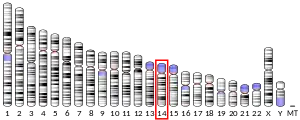TATA-box binding protein like 2 is a protein that in humans is encoded by the TBPL2 gene.[5] The TBPL2 protein is also known as TBP-related factor 3 (TRF3) and TATA binding protein 2 (TBP2). The protein was independently discovered in three laboratories as a vertebrate-specific family member of TATA-binding protein (TBP). [6][7][8] Orthologs have been identified in mouse, frog (Xenopus tropicalis) and fish (Danio rerio). Whereas the TBP gene is found in all eukaryotes, TBPL2 is only found in vertebrates.[9][10]
Molecular properties
Similar to TBP, TBPL2 can bind to the TATA box. It interacts with other general transcription factors such as TFIIA and TFIIB and promotes transcription initiation in vitro.[7][8] The core domain, which mediates this binding to DNA, shows 95% identity between TBP and TBPL2.[10] The N-terminal domain of TBPL2 exhibits only limited homology to that of TBP.
Expression and function
Early reports mistakenly suggested a wide expression pattern of TBPL2. The main site of expression, however, is the oocyte, where it acts as a replacement factor for TBP.[8][11][12][13] Knockout mice are normal and viable, but females are not fertile in the absence of TBPL2 due to a defect in folliculogenesis. [14] TBPL2 has also been identified as a factor necessary to reprogram stem cells to oocytes.[15]
References
- 1 2 3 GRCh38: Ensembl release 89: ENSG00000182521 - Ensembl, May 2017
- 1 2 3 GRCm38: Ensembl release 89: ENSMUSG00000061809 - Ensembl, May 2017
- ↑ "Human PubMed Reference:". National Center for Biotechnology Information, U.S. National Library of Medicine.
- ↑ "Mouse PubMed Reference:". National Center for Biotechnology Information, U.S. National Library of Medicine.
- ↑ "Entrez Gene: TATA-box binding protein like 2". Retrieved 2018-01-31.
- ↑ Persengiev SP, Zhu X, Dixit BL, Maston GA, Kittler EL, Green MR (December 2003). "TRF3, a TATA-box-binding protein-related factor, is vertebrate-specific and widely expressed". Proceedings of the National Academy of Sciences of the United States of America. 100 (25): 14887–91. Bibcode:2003PNAS..10014887P. doi:10.1073/pnas.2036440100. PMC 299843. PMID 14634207.
- 1 2 Bártfai R, Balduf C, Hilton T, Rathmann Y, Hadzhiev Y, Tora L, et al. (April 2004). "TBP2, a vertebrate-specific member of the TBP family, is required in embryonic development of zebrafish". Current Biology. 14 (7): 593–8. doi:10.1016/j.cub.2004.03.034. PMID 15062100. S2CID 20128.
- 1 2 3 Jallow Z, Jacobi UG, Weeks DL, Dawid IB, Veenstra GJ (September 2004). "Specialized and redundant roles of TBP and a vertebrate-specific TBP paralog in embryonic gene regulation in Xenopus". Proceedings of the National Academy of Sciences of the United States of America. 101 (37): 13525–30. Bibcode:2004PNAS..10113525J. doi:10.1073/pnas.0405536101. PMC 518790. PMID 15345743.
- ↑ Duttke SH (March 2015). "Evolution and diversification of the basal transcription machinery". Trends in Biochemical Sciences. 40 (3): 127–9. doi:10.1016/j.tibs.2015.01.005. PMC 4410091. PMID 25661246.
- 1 2 Akhtar W, Veenstra GJ (June 2011). "TBP-related factors: a paradigm of diversity in transcription initiation". Cell & Bioscience. 1 (1): 23. doi:10.1186/2045-3701-1-23. PMC 3142196. PMID 21711503.
- ↑ Gazdag E, Rajkovic A, Torres-Paddilla ME, Tora L (July 2007). "Analysis of TATA-binding protein 2 (TBP2) and TBP expression suggests different roles for the two proteins in regulation of gene expression during oogenesis and early mouse development". Reproduction. 134 (1): 51–62. doi:10.1530/REP-06-0337. PMID 17641088.
- ↑ Akhtar W, Veenstra GJ (August 2009). "TBP2 is a substitute for TBP in Xenopus oocyte transcription". BMC Biology. 7: 45. doi:10.1186/1741-7007-7-45. PMC 2731028. PMID 19650908.
- ↑ Yu C, Cvetesic N, Hisler V, Gupta K, Ye T, Gazdag E, Negroni L, Hajkova P, Berger I, Lenhard B, Müller F, Vincent SD, Tora L (22 December 2020). "TBPL2/TFIIA complex establishes the maternal transcriptome through oocyte-specific promoter usage". Nature Communications. 11 (1): 6439. Bibcode:2020NatCo..11.6439Y. doi:10.1038/s41467-020-20239-4. PMC 7755920. PMID 33353944.
- ↑ Gazdag E, Santenard A, Ziegler-Birling C, Altobelli G, Poch O, Tora L, Torres-Padilla ME (September 2009). "TBP2 is essential for germ cell development by regulating transcription and chromatin condensation in the oocyte". Genes & Development. 23 (18): 2210–2223. doi:10.1101/gad.535209. PMC 2751983. PMID 19759265.
- ↑ Hamazaki N, Kyogoku H, Araki H, Miura F, Horikawa C, Hamada N, Shimamoto S, Hikabe O, Nakashima K, Kitajima T, Ito T, Leitch HG, Hayashi K (December 2020). "Reconstitution of the oocyte transcriptional network with transcription factors". Nature. 589 (7841): 264–269. doi:10.1038/s41586-020-3027-9. hdl:10044/1/86296. PMID 33328630. S2CID 229293175.
Further reading
- Akhtar W, Veenstra GJ (June 2011). "TBP-related factors: a paradigm of diversity in transcription initiation". Cell & Bioscience. 1 (1): 23. doi:10.1186/2045-3701-1-23. PMC 3142196. PMID 21711503.



